As a project manager, you always strive to get your teams working faster and more productively without completely overhauling their workflows.
Most project managers striving to get their teams working more efficiently are familiar with Kanban and Scrum — two popular project management frameworks that bring the Agile methodology to life.
While they have different processes, both Scrum and Kanban aim to help teams achieve the same goals of more productive work, greater team collaboration, and quicker product delivery through improved workflow.
But with some team leaders championing Scrum and others promoting Kanban, how do you know which framework to use for your team? And more importantly, what exactly is the difference between Scrum and Kanban?
In this article, we’ll cover the main differences between Kanban and Scrum, identify their similarities, and provide tips for choosing the right methodology. Plus, if you like the idea of a hybrid approach, (because why limit yourself by picking just one!) we’ll show you how to get the best of both frameworks with monday.com.
What is Kanban?
Kanban is an Agile project management framework that uses visual goals and tasks to manage workflows. This is often through the use of a Kanban board: a series of cards and columns representing individual tasks and their stages. Its continuous workflow structure and real-time communication keep teams Agile, ready to adapt and improve processes.
Kanban is best known for its use within DevOps software development, but its emphasis on visualization makes it excellent for all types of business teams — especially those with numerous incoming requests that vary in priority and size.
For example, a project manager using Kanban methodology would break down each project task into a card, with an assigned priority level and person. By breaking down a project through this visually intuitive system, the team can quickly understand a project’s pipeline, what needs to be done, who is in charge of what, etc.
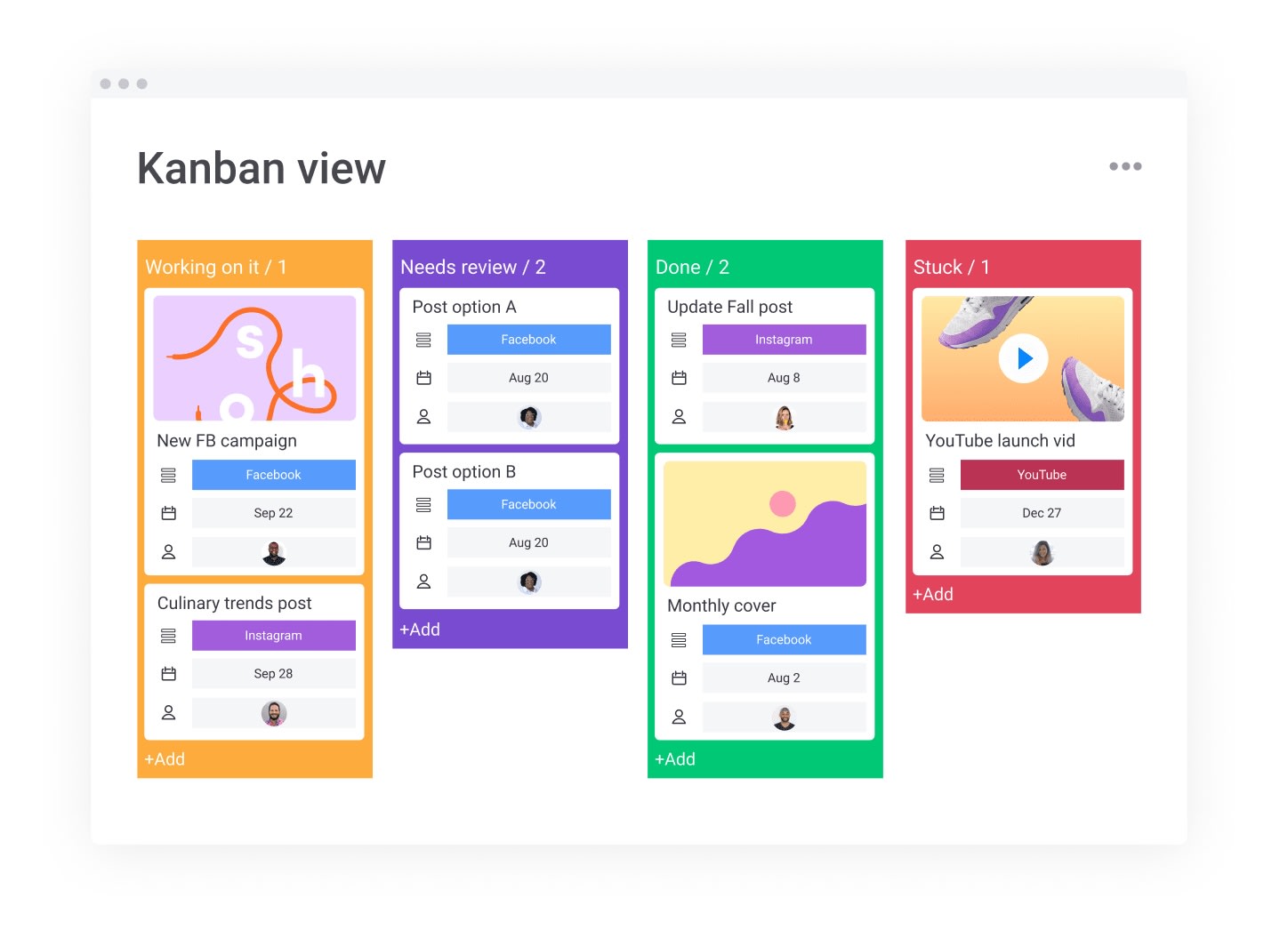
What is Scrum?
Scrum is another Agile project management approach with the same general goal of Kanban — to make project workflows more effective for teams. However, rather than an emphasis on visual organization, Scrum helps teams structure and manage their work through short iterative cycles. Read more about these frameworks in our piece all about agile and scrum.
Scrum prescribes breaking work into goals for completion within time-boxed iterations called sprints. There’s a very specific method to ensuring the success of Scrum which involves pre-defined roles and daily stand-up meetings, or daily scrums, to assess progress. It’s widely used in software development and other industries.
It’s based on empirical process control, where decisions come from observation, experience, and experimentation, and has three pillars — transparency, inspection, and adaptation.

Kanban vs. Scrum: What are the differences
Now that we have a general understanding of both frameworks, let’s get to the big question: What are the differences between Kanban and Scrum?
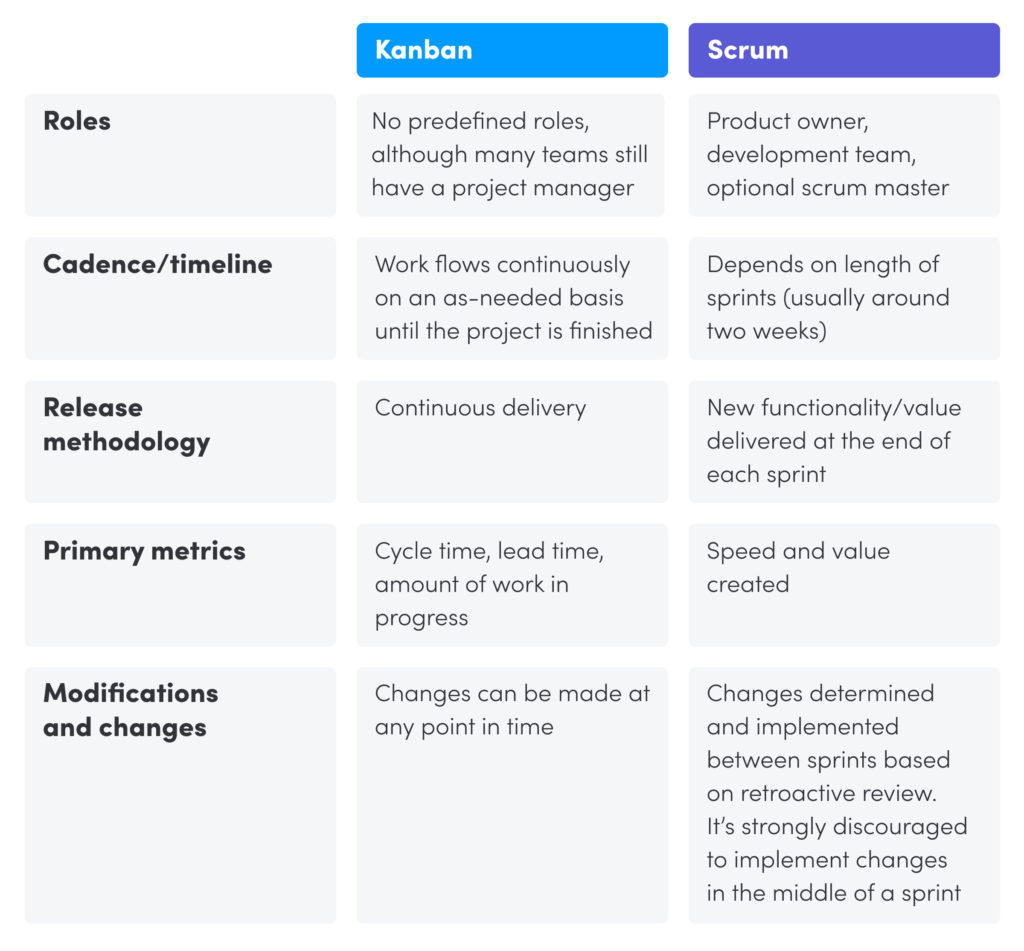
Kanban vs. Scrum: Roles and responsibilities
Kanban has no predefined roles, although most teams will have a project manager. Team members collaborate and help one another to balance the workload.
On the other hand, in Scrum, there are three defined roles:
- Product Owner: Controls the overall vision and objectives, liaises with stakeholders, and directs the team.
- Scrum Master: Reinforces Scrum values during meetings, dictates the timelines, and keeps team members on-task.
- Team members: Execute the agreed work from the sprint planning.
Kanban vs. Scrum: Cadence and timeline
With the Kanban method, work flows continuously until the project ends. It’s more flexible and does not have set beginning and finishing dates for specific activities — no prescribed sprint length or fixed schedule.
On the other hand, the heart of the Scrum method are time-boxed iterations, typically lasting one to four weeks, known as sprints. Each sprint has a set start and end date, and work is delivered in blocks within these sprints, creating a more predictable environment.
Kanban vs. Scrum: Product release methodology
In Kanban, deliverables get released at their own pace when ready and without a set schedule. This flexible approach means a deliverable could be released early or late without needing a review.
On the other hand, in Scrum, deliverables are typically released at the end of each sprint. This less flexible approach means the release of deliverables links more closely to the sprint schedule and sprint review.
Kanban vs. Scrum: Metrics
The primary metric in Kanban is cycle time, which measures how long it takes to complete one part of a project from beginning to end. It helps teams to identify potential bottlenecks.
In Scrum, the primary metric is velocity, which measures the amount of work a team completes in a sprint. It helps teams understand how much work they can achieve in a given time frame, enabling more accurate planning and forecasting.
Kanban vs. Scrum: Project flexibility
In Kanban, teams can make changes at any time mid-project to allow for continuous improvement. It’s a more adaptable and less rigid approach to managing modifications and changes.
In Scrum, any changes and modifications during the current sprint are discouraged, and teams must address requests in the next sprint.
Kanban vs. Scrum: What do they have in common?
Despite the differences between, Scrum and Kanban, they share several commonalities. After all, they share the same goal of boosting efficiency through the Agile framework.
- Both use visual boards to track progress and manage work.
- Both promote continuous improvement in achieving the project goal.
- Both frameworks encourage process improvement, team collaboration, and knowledge sharing.
While they have different approaches, they share common principles and values, making them practical for managing projects and embracing the Agile methodology.
Kanban vs. Scrum: Advantages and disadvantages
If both Scrum and Kanban help teams achieve the same goals, how can you determine which is best for your team? Let’s weigh up the pros and cons of each Agile framework.
Kanban pros:
- Enables continuous delivery and provides the flexibility to make adjustments at any time in the production cycle.
- Focuses on visualizing workflows and optimizing processes, leading to reduced waste and increased efficiency.
- Suits flexible, collaborative, self-organizing teams.
Kanban cons:
- Deliverables can potentially move slower since there are no time constraints.
- Outdated Kanban boards can derail productivity if not properly maintained.
Scrum pros:
- Provides a structured framework for managing work through fixed sprints, leading to a predictable and transparent schedule.
- Helps teams structure and manage their work through fixed deadlines and requirements.
- Suits cross-functional teams with clear roles and responsibilities.
Scrum cons:
- Requires regular meetings to review sprints and find opportunities for improvement.
- May prove challenging for less experienced team members to manage effectively.
Ultimately, deciding which framework is best will depend on the types of projects your team works on and their willingness to adopt a new methodology.
Kanban vs. Scrum: When to use which?
After looking at the pros and cons of each framework, It’s easier to understand the kinds of teams and projects each would be the best fit for.
Here are some simple shortcuts to help you decide which methodology is best for your team.
Use Scrum if:
- You have strict stakeholder deadlines and need to know the exact deliverable dates of a project. Because the sprint method is inherently predictable, it’s good for teams working with exact due dates or specifically planned releases. The sprint schedule accounts for everything, so there’s no room for uncertainty regarding when and how each task or aspect of a project will be completed. Teams can rest assured their project will stick to a specific cadence.
- Your project relies on heavy cross-team collaboration. Because Scrum requires teams to have specifically defined roles, consistent feedback, and daily “stand-up” meetings, it’s easy for many different stakeholders to stay aligned on what exactly is going on at all times.
- You have clear goals, ideas, and priorities for your project. Scrum is all about predictability, so everything including project roles, deadlines, and specific processes is planned out in advance. This is great for projects that have an extremely specific end game, and limited room for flexibility within processes.
- You’re working on a long-term project that needs iterative feedback. If you’re working on a project that you know will go through many rounds of (planned) changes and improvements before it’s finished, Scrum allows for this improvement over time through iterative feedback. For example, It’s great for teams developing new products that will need multiple stages of feedback before a release.
Use Kanban if:
- You need a more go-with-the-flow approach. If you don’t have structured roles and deadlines, and want to be able to make changes to a project without waiting for the end of a mapped-out sprint, Kanban is the choice for you. It allows teams to adapt quickly to shifting priorities so it’s simple to make instant changes in a quickly-evolving project.
- Your project encompasses various tasks with different priorities and deadlines. If you’re working on a project that deals with unpredictable requests and varying priorities, Kanban is ideal. It’s simple to change around a product plan if an urgent request comes in, which is great for teams like Customer Support.
- Your team values visualization. Kanban boards make it easy to visualize specific workflows, quickly spot bottlenecks, and instantly access specific metrics in one place.
Combine Kanban and Scrum: Get the best of both worlds with a hybrid approach
Many teams choose to use Kanban alongside Scrum or combine the practices in a hybrid approach. There are two ways to operate the two frameworks together.
Adopt the scrumban framework
The first approach is to try Scrumban — a hybrid framework that combines the structure of Scrum with the flexibility and visualization of Kanban.
Scrumban uses short iterations — similar to Scrum sprints — to control and manage deliverables. Plus, visual boards — like Scrum and Kanban boards — to track the status of tasks and execute work in progress.
Scrumban is a good fit for specific use cases where Scrum or Kanban alone isn’t sufficient, such as software development projects with evolving requirements or projects encountering scope creep. It allows teams to benefit from both the prescriptive nature of Scrum and the freedom of Kanban, making it a flexible and efficient method for managing projects of any size.
Consider a digital solution that enables both
The alternative to Scrumban is to choose a software platform that allows you to use the key features from both frameworks. With this approach, you can prioritize one framework over the other while still benefiting from specific features that you find helpful.
For example, with monday dev, you get a Kanban view and a Scrum Sprint Planning Template. At the same time, the platform offers enough structure to help individuals stay on top of their tasks, communicate with colleagues, and complete their work efficiently with 150+ code-free automations.
With elements of both Scrum and Kanban, monday dev brings teams together in one digital workspace designed for collaboration, annotation, planning, and tracking work with real-time dashboards to make data-driven decisions.
monday.com: the seamless solution to fuse Kanban and Scrum together
Choosing between Kanban and Scrum is like taking different routes to the same destination. The ride will be different, but eventually, you’ll get to the same place. Each framework has benefits, and each helps teams work faster, boost collaboration, and deliver greater value.
In the end, deciding which one is best for your team will depend on understanding the scope and complexity of your projects, as well as the willingness of your teammates to embrace new systems of work.
Instead of picking one framework, the hybrid approach has gained popularity for teams that want to choose the elements of each that best fit their needs. But for this to work, a team needs a powerful, intuitive, competent project management platform.
With monday dev, built on the robust monday.com Work OS, you get the best of both Kanban and Scrum functionality baked into one collaborative platform, including:
- Workflow management: Streamline your entire development workflow, including roadmap, sprints, backlog, bug tracking, and retrospective elements, in one place.
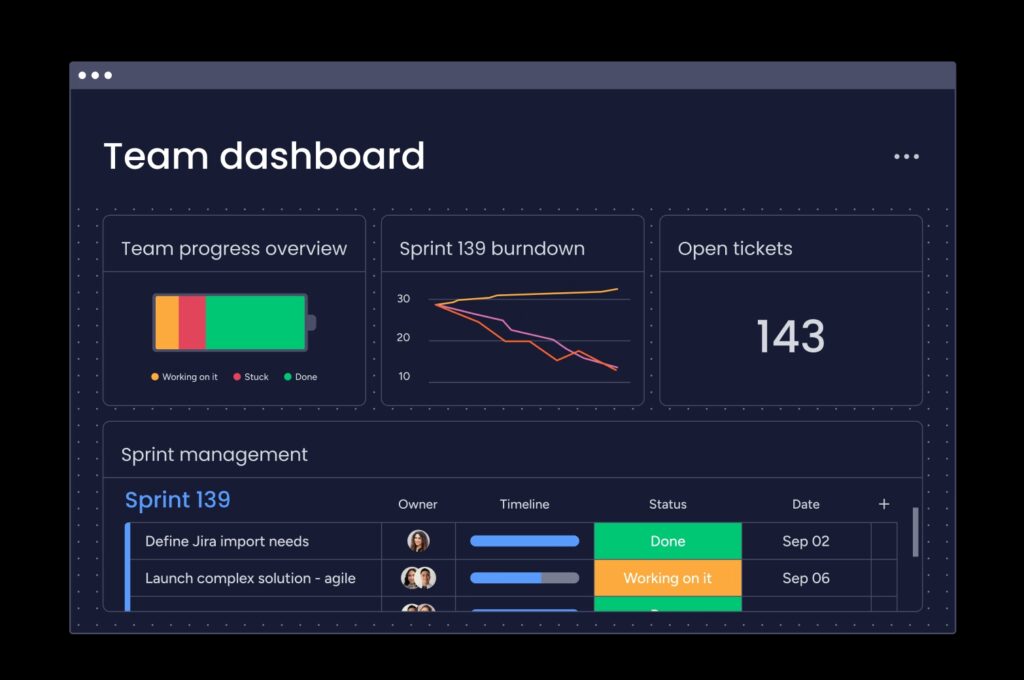
- Sprint management: Empower teams to easily manage and oversee their scrum sprints from start to finish in one place, from sprint planning and daily stand-ups to retro and sprint reviews.
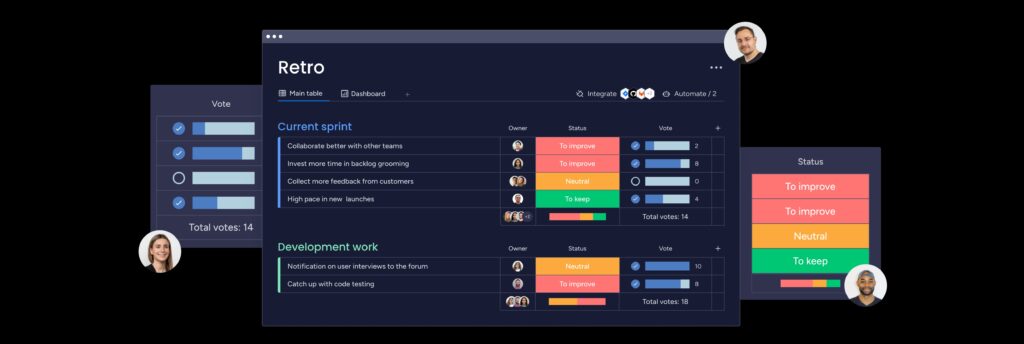
- Kanban View: Transform any workflow into a customizable Kanban board with the click of a button. Create a continuous visual workflow and gain full transparency into your team’s development tasks to maximize efficiency.
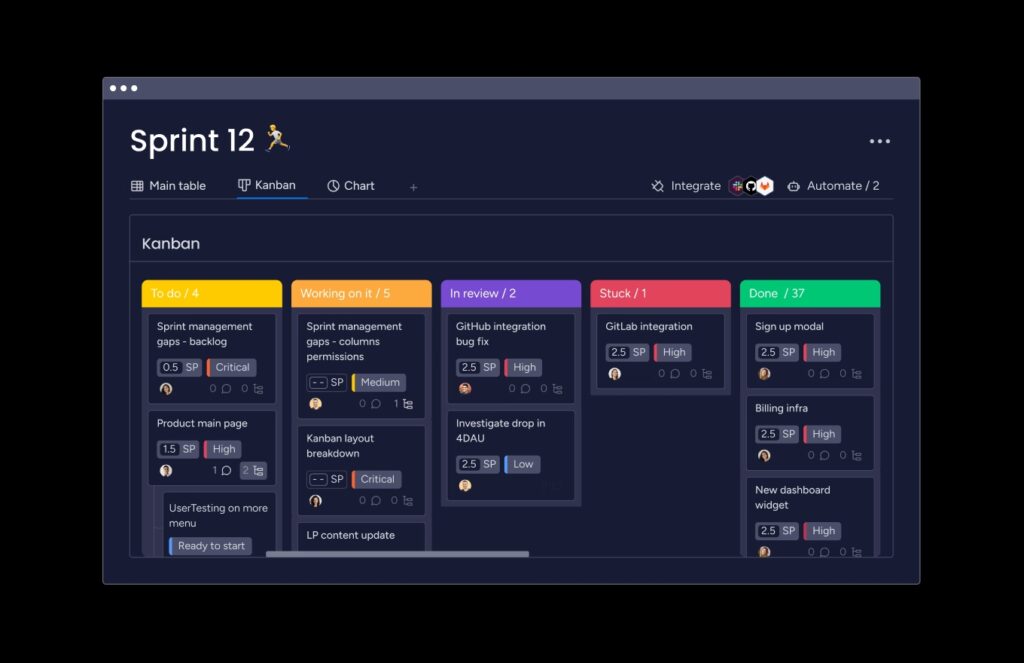
- Workload View: Visualize workloads across projects, with high-level and granular data, to see how task hours spread across team members.

- Agile reporting: Customize your own real-time reports, including a velocity chart and burnup or burndown charts.

With monday dev, your team can communicate, provide status updates, ask questions, solve problems, share information, and visualize progress with a Kanban, Scrum, or hybrid model.
Kanban vs scrum
When should you use Kanban vs. Scrum?
Deciding between using either Kanban or Scrum methodologies depends on the type of team and their needs. Overall, Kanban is better for teams that value flexibility, visualization, and flow while Scrum is best suited for teams needing more structured planning, and predictable time-specific outcomes. There’s not always a need for teams to pick between Kanban vs. Scrum, however, as it’s possible to combine these useful approaches.
How is Kanban different than Scrum?
Kanban and Scrum are both Agile project management methods used to organize teams’ work more efficiently, but Kanban focuses on visual, flexible project organization through the use of Kanban boards, while Scrum focuses on breaking up work into fixed-length time iterations.
Can Kanban have sprints?
Unlike Scrum methodology, Kanban does not require sprints, and instead uses different methods like project visualization to replace the need for sprints. However, teams that choose to combine both Kanban and Scrum for their project management approach, can incorporate sprints into their general Kanban structure, sometimes known as “Kanban sprints.”
 Try monday dev
Try monday dev 

